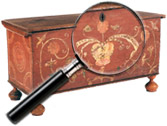|
|
Van Briggle Pottery
The Van Briggle Pottery was established in Colorado Springs, Colorado in 1900 by Artus Van Briggle and his wife Anne Gregory and was producing art wares by 1901. Artus Van Briggle had been a leading decorator at the Rookwood Pottery in Cincinnati and had studied abroad before his poor health forced the move to Colorado.
The early pieces were modeled by Artus and Anne and a mold was made to produce [...] Click here to continue reading.
Dedham Pottery
The Dedham Pottery manufactured over fifty patterns of tableware – almost all having horticultural or zoological based designs – in East Dedham, Massachusetts, during the period 1895 to 1943. It was the successor to the Chelsea Pottery (1891 to 1895) and operated by the Robertson family of potters. Dedham ware is noted for its unusual designs in cobalt and white and for its crackle pattern – sometimes in the form of a [...] Click here to continue reading.
Jadeite, Jade-ite, Jadite
“Jadite” generally refers to the pale green color that can be opaque “milk” glass or painted on the inside. It is also a trade name for an opaque green that Jeannette Glass Co. (Jeannette, PA) made. The name “Jade-ite” was used by anchor Hocking. Other pieces in opaque green were made by Fenton Glass Co., called simply “Jade”, and McKee Glass Co., called Jade Green. (300 Years of Kitchen Collectibles, Linda [...] Click here to continue reading.
Lustre ware
Produced in all the major British ceramic centers from about 1805 to 1870, lustre ware of all types was created by introducing a metalic solution to the base pottery before firing. This solution was most often a mixture of nitric and hydrochloric acids – called aqua regia – plus the metalic element required to produce the desired color. The addition of platium and arsenic produced a sliver lustre, gold in aqua regia [...] Click here to continue reading.
Parian was first marketed in 1846 by the British pottery firm of Copeland as a white porcelain-like body, slightly translucent. Named “Parian” by the Minton pottery, this ware was introduced by Wedgwood in 1848 as “Carrara Ware”. This pottery type has come to be known as Parian generically, regardless of manufactory, and in its pure white form, was used mainly for figures, groups and busts. Wedgwood also made other shapes in Parian, particularly ornamental [...] Click here to continue reading.
Wooton Patent Desks
The Wooton Desk Manufacturing Co. was established in Indianapolis, Indiana in 1870 by William S. Wooton, a former minister turned furniture maker, and remained active until 1893.
The company is known for a group of elaborate walnut folding desks, first patented in 1874, in the Victorian Eastlake style which were essentially self-contained offices. These elaborate cabinets came in four grades: “Ordinary,” “Standard”, “Extra”, and “Superior”. The desks were expensive, prestige furniture, [...] Click here to continue reading.
Gouda Pottery
Pottery has been made in Gouda, Holland, since at least the 1600′s. Today’s collectors most often encounter the work of two later potteries, the “Zenith” pottery in operation during the 18th century, and the “Zuid-Hollandsche” pottery which opened in 1880 and continued in operation until the on-set of World War II. The latter firm specialized in brightly colored products in an Art Nouveau or Art Deco style and marked their wares “Gouda”.
Vaseline Glass
Vaseline glass obtains its distinctive color by adding a small amount of uranium to the glass formula. It usually can be detected with a black light.
SchucoToys
Schuco toys were manufactured in Germany from the 1930′s to the 1950′s by Schreyer & Co. which was founded in 1912 and produced their toys under the “Schuco” tradename. Their toys are marked either “Germany” or “U.S. Zone-Germany”, but have been reissued with other marks.
The Japanese Taisho Period
Taisho Emperor, Yoshihito. (1879-1926). Yoshihito was the 123rd emperor, this traditional list included several nonhistorical monarchs. He was posthumously given the name, Taisho Emperor; called after the name of the era over which he presided, the Taisho Era (1912-1926). His personal name was Yoshihito and he was the third son of the Meiji Emperor.
Unlike his father the Meiji Emperor, he did not play an active role in Japanese politics. [...] Click here to continue reading.
|
Recent Articles
- Charles Alfred Meurer – American Artist & Tromp L’Oeil Artist
- Sendak, Maurice – American Artist & Writer
- Godie, Lee – American Artist
- Davis, Vestie – American Artist
- Bartlett, Morton – American Artist
- Mackintosh, Dwight – American Artist
- Evans, Minnie Jones – African-American Artist
- Mumma, Ed (Mr. Eddy) – American Artist
- Nice, Don – American Artist
- Savitsky, John (Jack) – American Artist
- Gordon, Harold Theodore (Ted) – American Artist
- Dial, Thornton – African-American Artist
- Doyle Sam – American Artist
- Johnson, Lester Frederick – American Artist
- Finster, Howard – American Artist
|
|
